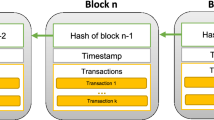Abstract
Various computing environments are constantly emerging which are using different technology platforms and security mechanisms from each other. The development of network technology makes cross-domain access between various systems necessary, which requires seamless information sharing and data exchange between systems, thus eliminating the phenomenon of information islands. With its unique consensus mechanism and compatible encryption algorithms, it has gradually attracted attention in various fields. Many people believe that blockchain technology is a revolution in Internet technology in the future, which is a huge innovation in information infrastructure technology as well. In order to ensure a high QoS of the data grid, the system needs to overcome many unstable factors of the network and the grid nodes. Resource (capability) reservation, copy deployment, buffer mechanism, parallel data transfer, and data storage and recovery are the main means to solve such problems. Above all, this paper proposed a QoS optimization system for complex data cross-domain request based on neural blockchain structure. Experimental results show that the proposed method has higher robustness and efficiency.















Similar content being viewed by others
Change history
12 December 2022
This article has been retracted. Please see the Retraction Notice for more detail: https://doi.org/10.1007/s00521-022-08157-6
References
Wang Qingbo, Jin Xin, He Le et al (2009) Virtualization and cloud computing. Publishing House of Electronics Industry, Beijing, pp 1–25
National Institute of Standards and Technology homepage. http://www.nist.gov/
James HA, Hawick KA (2005) Scientific data management in a grid environment. J Grid Comput 3:39–51
Vazhkudai S, Schopf JM (2003) Using regression techniques to predict large data transfers. Int J High-Perform Comput Appl 17(3):249–260
Li J (2007) Research on resource management related strategies and algorithms of data grid. PhD thesis of Chongqing University, pp 1–5
Zhou D (2004) Key theory and technology research of service grid with QoS Guarantee. Doctoral Dissertation of Huazhong University of Science and Technology, pp 29–30
Kouzes RT, Anderson GA, Elbert ST et al (2009) The changing paradigm of data-intensive computing. IEEE Comput 42(1):26–34
Jun Xu, Liu Quanbo, Li Yushun et al (2010) Service-oriented grid computing: a new distributed computing system and middleware. Science Press, Beijing
Brandic I, Pllana S, Benkner S (2008) Specification, planning, and execution of QoS-aware Grid workflows within the Amadeus environment. Concurr Comput 20:331–345
Ali R, Barrdear J, Clews R et al (2014) The economics of digital currencies. Soc Sci Electron Publish 54:276–286
Fujiki H, Tanaka M (2014) Currency demand, new technology, and the adoption of electronic money: micro evidence from Japan. Econ Lett 125(1):5–8
Qiu Y, Bi Y, Li Y, Wang H (2018) High resolution remote sensing image denoising algorithm based on sparse representation and adaptive dictionary learning. In: Computational vision and bio inspired computing. Springer, Cham, pp 892–901
Wang Xiaogang (2015) Deep learning in image recognition. Commun CCF 11(8):15–23
Sui Z (2017) Hierarchical text topic modeling with applications in social media-enabled cyber maintenance decision analysis and quality hypothesis generation (Doctoral dissertation, The Ohio State University)
Parker N, Allen TT, Sui Z (2017) K-means subject matter expert refined topic model methodology (No. TRAC-M-TR-17-008). TRAC-Monterey Monterey United States
Allen TT, Sui Z, Parker NL (2017) Timely decision analysis enabled by efficient social media modeling. Decis Anal 14(4):250–260
Brogi C, Huisman JA, Weihermüller L, Pätzold S, von Hebel C, van der Kruk J, Vereecken H (2018) Large-scale subsurface characterization using image classification of multi-configuration electromagnetic induction data assisted by direct soil sampling. In EGU general assembly conference abstracts, vol 20, p 8249
Aljawarneh SA, Moftah RA, Maatuk AM (2016) Investigations of automatic methods for detecting the polymorphic worms signatures. Future Gener Comput Syst 60:67–77
Aljawarneh SA, Alawneh A, Jaradat R (2017) Cloud security engineering: early stages of SDLC. Future Gener Comput Syst 74:385–392
Aljawarneh SA, Vangipuram R, Puligadda VK, Vinjamuri J (2017) G-SPAMINE: an approach to discover temporal association patterns and trends in internet of things. Future Gener Comput Syst 74:430–443
Aljawarneh S (2011) A web engineering security methodology for e-learning systems. Netw Secur 2011(3):12–15
Aljawarneh S, Yassein MB (2017) A resource-efficient encryption algorithm for multimedia big data. Multimed Tools Appl 76(21):22703–22724
Aljawarneh S, Aldwairi M, Yassein MB (2018) Anomaly-based intrusion detection system through feature selection analysis and building hybrid efficient model. J Comput Sci 25:152–160
Hossain MS, Xu C, Li Y, Bilbao J, El Saddik A (2018) Advances in next-generation networking technologies for smart healthcare. IEEE Commun Mag 56(4):14–15
Acknowledgement
The research is supported by the: 1. Project funded by National Key R&D Program of China: International cooperation between governments in scientific and technological innovation (No.YS2017YFGH002008): Horizon 2020 Urban Inclusive and Innovative Nature; 2. Project funded by China Postdoctoral Science Foundation: Assessment and optimization of urban lifeline resilience based on the big data; 3. Project funded by the Project of Macau Foundation: Social mutual aid (disaster relief) application.
Author information
Authors and Affiliations
Corresponding author
Ethics declarations
Conflict of interest
The authors declare that they have no conflict of interest.
Additional information
Publisher's Note
Springer Nature remains neutral with regard to jurisdictional claims in published maps and institutional affiliations.
This article has been retracted. Please see the retraction notice for more detail: https://doi.org/10.1007/s00521-022-08157-6
Rights and permissions
Springer Nature or its licensor (e.g. a society or other partner) holds exclusive rights to this article under a publishing agreement with the author(s) or other rightsholder(s); author self-archiving of the accepted manuscript version of this article is solely governed by the terms of such publishing agreement and applicable law.
About this article
Cite this article
Deng, L., Li, D., Cai, Z. et al. RETRACTED ARTICLE: A QoS optimization system for complex data cross-domain request based on neural blockchain structure. Neural Comput & Applic 32, 16455–16469 (2020). https://doi.org/10.1007/s00521-019-04062-7
Received:
Accepted:
Published:
Issue Date:
DOI: https://doi.org/10.1007/s00521-019-04062-7




